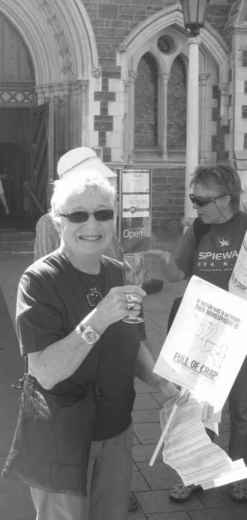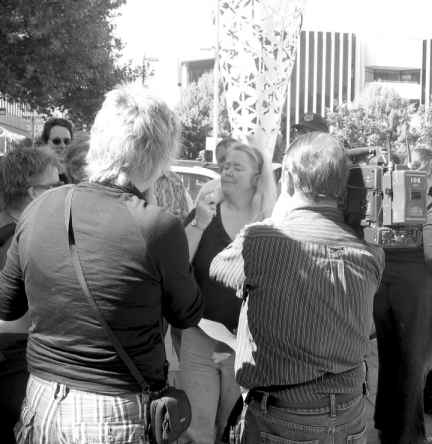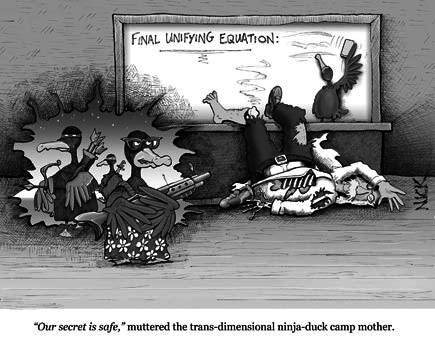Noel Townsley continues our series on the psychic roadshows touring New Zealand.
From a website to which I subscribe came an email notice of two upcoming events with “well-known psychic” Jeanette Wilson. She was doing psychic readings one evening, and the following evening Spirit Healing, described as “an extra-ordinary evening, one that may change your perception of this reality forever.”
Having been to an unimpressive evening with the “well-known psychic” Sue Nicholson recently (see NZ Skeptic 93), I decided my usual Tuesday night pub quiz would likely provide me with more satisfaction, but I would attend Jeanette’s Spirit Healing evening and see what this was all about.
The venue was Rotary House in Silverdale. I arrived right on 7.30pm to a medium-sized hall. In the first and smaller of two rooms was a table with various items for sale, and someone to collect my $40 pre-purchased ticket. From behind the dividing door I could hear Jeanette starting her talk and was quickly ushered through to a seat at the back. There were about 100, mostly older people, and definitely more women than men. I could see that quite a few, like me, had taken up a suggestion in the advert and brought their cameras, hoping to get a photo of one of those seemingly elusive spirits.
Jeanette began by explaining that when she used the term “entity” she was referring to a spirit – often referred to as the “soul” in living people, and as “spirit” once they had died, but that all were interchangeable terms for the same thing. She also said that there were over 2000 spirit doctors and surgeons that she could call upon – these were the same ones that the famous John of God in Brazil uses, and like him, she was also dressed in white, as to better see the spirit/entities. She was also barefoot as this “grounded” her to the energies.
She said some doctors came more frequently than others and mentioned various names. None sounded like Louis Pasteur, Joseph Lister, or Christiaan Barnard. A number of saints were mentioned as well. She said she had recently done a very successful healing session in Palmerston North where she said that many orbs, entities, and even a floating face had been photographed.
Things looked promising for tonight. She then told us about her upbringing in England, her late childhood in which she realised she could see spirit, and her dramatic call to heal. This came when, as a bank loans officer, a man who had come to see her about a loan asked her to heal his bad back. Not sure what to do, she muttered the prayer she had learnt only a few months earlier while attending a healing workshop.
The result, she says, was for three entities to appear. One took over her body; the other two took the man (now lying down presumably), one by his feet and the other by his head, and proceeded to stretch him out straight, with much loud moaning from the man. If her next loan appointment was waiting outside, I wonder what they thought. Eventually the moaning subsided and the man claimed his back was much improved. The next day he went to his chiropractor, who reportedly said his back was now perfectly aligned.
News of this healing incident spread quickly, and she was soon unpopular with the healing school, who considered her to be a novice. However, while waiting at the tube station, an old man walked up to her and told her she was a healer, repeating this several times. When she realised he was “not of this world”, the man promptly vanished, but she now knew what she was destined to do.
Jeanette related another story of how she was asked to see an (unnamed) peer in the House of Lords, who was due to swim the Thames in a week’s time for a charity event, but was unable to free a frozen shoulder. She was able to fix this in a few minutes, and her fame spread quickly, to the extent that she was being hounded by the unwell – rather like Princess Diana had been by the paparazzi, she said.
Expectations
Jeanette then told us about some of her recent healings and what we could expect to experience. These healings she said usually happen within a few minutes, or even within a few seconds of her working with someone. Also, as she was healing, we would likely see auras, orbs of light, or even a healing entity. The entities, she explained, do the actual healing; she is just a conduit for them. She warned us that at times she would be making quite loud noises, but not to be concerned by this, and also to have our cameras ready, as this was the best time to take photos and perhaps capture an image of an entity, orb or aura, as this was when they were most active. We may also notice that the room, or parts of it, may become hot or cold – this would be a result of the energies, she said.
She explained she believed in a higher power, although she did not adhere to any particular denomination. We were then asked to close our eyes and recite the Lord’s Prayer, followed by a rosary if we knew it, to assist us in the night’s healing session.
Jeanette asked if there was anyone that had a visible physical condition, rather than a sore back for example, that was just qualitative. This, she said, was to visibly “prove” to us that healing was going on. Several hands went up, including an elderly lady in the front row, with a pair of crutches to her side. Jeanette asked her name and what was wrong with her. Her name was Iris she replied, and she had a problem with both feet, ankles, legs, and knees, which resulted in her being unable to walk any distance without crutches or use of a wheelchair. “I’ll come back to you Iris,” Jeanette said, and asked again if there was someone with a smaller observable condition.
A woman said she was unable to lift her left arm above her head and demonstrated the lack of mobility. Jeanette got to work, rotating both hands in small circles very quickly about half a metre from the “patient” (as she often referred to them) and at the same time making a continuous “Eeee” noise. As she worked she again reminded us this was the time when spirits/entities would likely appear. She advised that the rapid movement of her hands was not controlled by her, but by the entities, although it seemed to make her puff a bit.
During a break in the “Eeeeee’s” she asked if anyone had taken any photos of orbs etc. Although I had seen and photographed nothing, one person near the front said they had, and a woman in a purple sweater near the back of the room ecstatically claimed that she could currently see a purple aura around the patient, and also a single entity just behind her. During the break I overheard someone say that the woman who saw the entity was also a psychic.
Jeanette continued to work on our first patient’s problematic left shoulder but then moved to the right side, directed by the entities. After a few minutes, with breaks for attempts to lift both arms, it appeared that the patient could now lift her right arm up further than she could before; however the problematic left arm remained defiantly down.
All-knowing entities
Jeanette explained that the entities, who she said had scanned us all as we entered the hall this evening, and see and know everything, often fix things that they consider to be of more benefit to us than we do, in some cases even fixing things we didn’t know we had. She assured our patient though, that she would gain more movement in her left arm later on, and presumably considering that getting the right arm to lift higher made for a successful healing, asked for a round of applause for our patient, and a new person to come forward.
Our next patient was a man who had a visible condition, trigger finger in both hands, which he said he had had for about four years. Jeanette said that in her experience, the longer the condition had persisted, the harder it was to heal. She began again with her rapid hand movements and the “Eeeee’s”. During breaks in the healing process the patient revealed that he also had a lot of damage to his back due to an accident that also caused him pain. Jeanette then said she had a pain in her back, which was a sign the entities had directed her to work on this area too. After a few minutes our patient claimed his back pain was improved, and there was some improvement in the trigger finger. However, at least from the back of the room, there appeared to be no difference in the fingers. Another round of applause for our patient, and then Jeanette directed herself to the previous patient, Iris.
Energy flows
Iris revealed further details of her condition; she had apparently damaged one knee in an accident, for which she was currently awaiting reconstructive surgery. Jeanette explained that all energies flow in and out of our feet – good energy flows up, bad energy flows down and out, so in Iris’s case her feet and ankle problems were due to blockages, which in turn created her knee problems.
Someone from the audience asked Jeanette to check with Iris if she had ever been bitten by something, as this might have caused her problems, as apparently it had done in themselves. Iris was sure she had not been bitten however. Jeanette worked on Iris for some time, getting her to stand up from time to time and try to walk a step or two without her crutches. She worked on Iris’s shoulders which the entities had indicated were a problem – left shoulder is past responsibilities, right shoulder is future responsibilities, Jeanette explained.
Iris looked like she might have been from a rest home, so hopefully she would not have too many future responsibilities to deal with, but if she did, at least she now had a strong right shoulder to cope with them. After a quite lengthy session, and despite Jeanette’s efforts, and Iris’s willingness, Iris seemed unable to make any progress in walking, and still resorted to her crutches, but as she returned to her seat, Jeanette said that she would experience an improvement in the next three days. A further round of applause followed.
During this part of the evening Jeanette had often asked the audience if they could feel the hot or cold energy around them. No one indicated they did, but maybe, as it was a hot and sticky summer evening in a room with no air-conditioning, this was too much for the energies to overcome.
A pause for breath
A break of about 20 minutes gave us an opportunity to take refreshments and look over the table of books, CDs, Jeanette’s upcoming courses, and various items including crystals, the Nu-Me pendant, and a radionic pendulum. The pendulum appeared to be nothing more than a small pear-shaped piece of wood attached to a string; however it was far more, as my later research on the internet revealed.
This pendulum, sculpted by the Aetherius Society’s craftsmen, is claimed to be an excellent tool to help develop your intuition and psychic abilities. “It reacts with the subconscious and higher conscious minds to give physical movements with the swing of the pendulum. With the correct use, you can tap the forces of intuition within yourself and then, by careful experimentation, many things can be determined.”
The Nu-Me pendant appeared to be a small coil of copper, about the size of a 50 cent piece. The manufacturers claim it “balances the personal energy system (chakra balancing and aura clearing) as well as protecting from all disturbed energy including EMF (Electro Magnetic Frequency) POLLUTION.”
The courses currently on offer by Jeanette include Reiki-$3000 to become a Reiki Master, and a Spirit Healing weekend, for an “investment” of only $300.
The second half
Upon our return to our seats, I noted a few more empty chairs than before the break.
Jeanette went back into her healing routine on a few more patients. I cannot report that any of the patients in the second half showed any marked physical improvement either. One gentleman, who had a sore shoulder which he said he had injured, but ACC had said was due to arthritis, was unable to lift his arm up fully above his head. Jeanette said that ACC was wrong in their assessment; it had been injured, and she was going to have to make very loud noises to ensure a healing – a high impact (accident) meant a high impact (sound) was needed to correct it. Following each healing action Jeanette would ask the man to lift his arm up, each time declaring a small improvement, although she acknowledged that he was not fully healed, but assured him the improvement would continue. As the crowd applauded, he returned to his seat. A review of photos from my camera showed that he could lift his arm no further on his first attempt, than on his last.
The finale
The last part of our evening was to be a mass healing by Jeanette. We were asked again to close our eyes and recite the Lord’s Prayer, and a rosary if we knew it, to assist this process. She advised that, as well as healing our own ailments, we could think of others and heal them remotely as well. We were to put a hand on the area that we felt needed healing, but if that area was embarrassing, or hard to reach, we could put our hand on our heart instead, as the entities would know what needed to be healed anyway.
The other important thing to remember was not to open our eyes during this time, as the negative energies being released could enter our bodies this way and undo any healing-a warning worth heeding. As I lost about 95 percent of my hearing in my right ear in a diving accident, I put my hand over my right ear and hoped for an improvement.
The only thing that happened at the time was that the constant tinnitus I also experience seemed to get a little louder. However, she did say we could expect more improvement over the coming days, so I was still hopeful.
Several weeks on, I cannot report any improvement in my hearing at all, but I will certainly let you know if there is.
Her last word of warning was to those who had been through her healing – because they had been through spiritual surgery, which was just like conventional surgery, the same advice applied – they must not exert themselves, lift heavy weights etc for some time. This seemed at odds with her claims that healing happens within a few minutes, and could replace conventional surgery. The recovery time at least, would appear to be the same from either “surgery”.
Gems of information
Amongst the gems of information that Jeanette gave out during the night was that a doctor (unnamed) had shown that cats purring can cause broken bones to heal quicker – one compensation of working at the SPCA I guess. She also said that another (also unnamed) doctor has discovered that people with cancer all have acidic bodies, and that changing your diet to make it alkaline will ensure you do not get cancer.
She also revealed some predictions – that New Zealand will be the first country to have full (presumably independently verified?) healing using her method, and will also be the first to open a crystal hospital – I took this to mean one that uses healing crystals, rather than one made of crystal, as the cost would be phenomenal.
In conclusion, I saw nothing that evening in any of the “patients” to indicate a marked or even a mild improvement in any visible condition, although some were reportedly healed of ailments they did not know they had. Those that claimed to be in less pain invariably still walked with a limp, or had difficulty mustering the affected limb to do anything it could not do before. I think most of the non-critical thinking people in that audience would say they saw proof of healing that night, judging from the queue of people wanting her to autograph their newly purchased books at the end of the evening.
I found it intriguing that Jeanette’s claim that aches in one part of the body indicated a non-physical problem, eg sore hands, means difficulty dealing with issues, seemed to be accepted by the audience – obviously the body is not as complex as we have been led to believe.
I was also puzzled by her statements that energy leaves and enters our bodies via our feet, but when asked to pray for our own healing we had to keep our eyes closed as bad energy can enter through our open eyes and affect the outcome. Also puzzling was her claim to not be of any religious denomination, but we were asked to recite a Christian prayer and the Roman Catholic rosary.
In regard to the auras, entities and orbs, I saw none, although one photo I took does have a circular, semi-transparent, white spot in it. As, in the same picture, I can clearly see the bright down-lights located in the ceiling, I think it is safe to assume that this was in fact lens flare. As for the claimed peach/orange coloured auras that were supposedly captured by some, I think this can easily be explained by the profusion of digital cameras in use, most of which produce a red/orange light in low light level situations to assist them to focus. The light emitted is roughly circular, and of course is aimed at the point of interest – in this instance Jeanette and the patient. With so many cameras in use, inevitably someone taking a photo will be recording these focusing lights in their pictures.
My concern with Jeanette Wilson is that people might see her claims of healing as a viable alternative to conventional medicine, and so forgo treatment. To her credit, Jeanette never suggested to anyone that they do that, but conversely, she never suggested to anyone that they seek conventional treatment for any of their ailments.
Despite Jeanette’s claim in her advertisement, my perception of this reality remains firmly intact.





